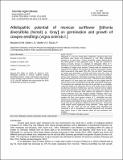| dc.description.abstract | Invasive plant species when introduced into new environments may result into a number of
ecological problems (Howard et al., 2000). They may influence other species through
pathways such as allelopathy or phytotoxicity (Samuel et al., 2005; Imeokpara and
Okusanya, 1994; Ayeni et al., 1997). Allelopathy is the inhibitory or stimulatory effect of a
plant on another by chemicals released from the donor plant to the environment (Taiwo and
Makinde, 2005; Bano et al., 2012). Allelopathy is a process by which plants release
chemical compounds in their vicinity (Rice, 1984). Studies have shown that different plant
parts release toxic metabolites into the soil that affect adversely germination and growth of
plants (Kumar et al., 2008). The importance of allelochemicals in agro-ecosystem has
attracted the attention of numerous scientists (Otusanya and Ilori, 2014; Pukclai and Kato … | en_US |

